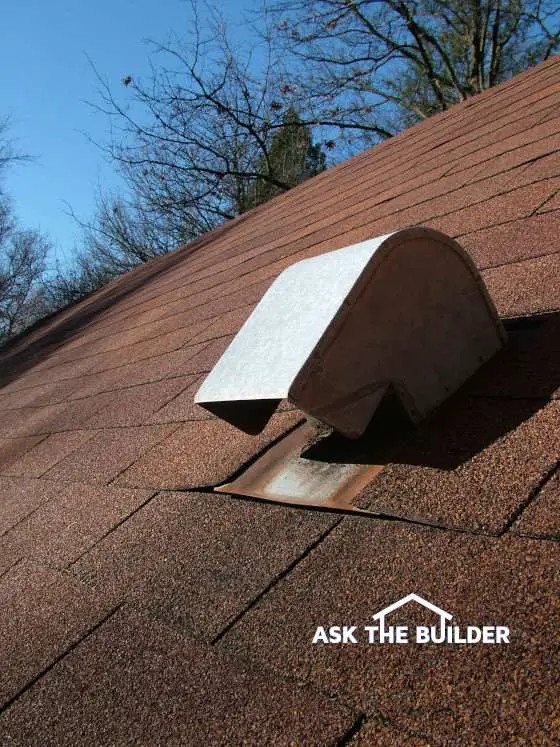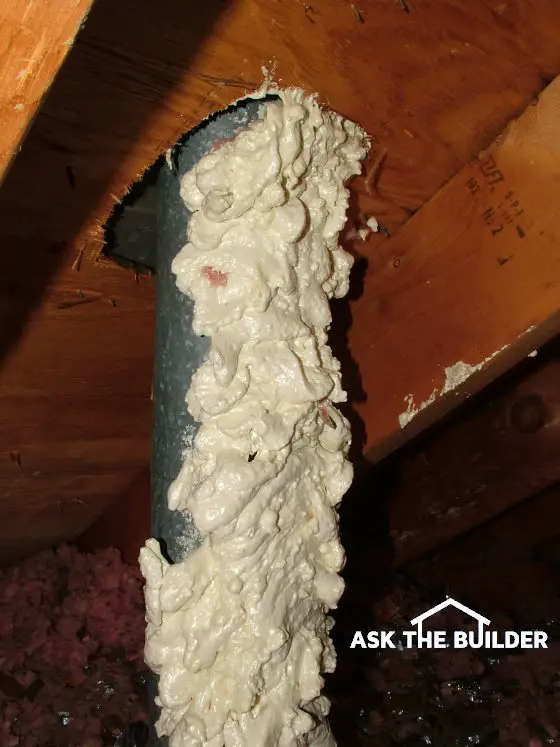Bath Vent Fan – Not Too Hard But Important Steps

Bath Vent Fan | Here is a special roof termination cap for the fan exhaust. There's a flapper damper just inside the outlet that stops insects and cold backdrafts from entering your bathroom. A new and improved one that I'd use had it been available is RIGHT HERE. CLICK or TAP HERE to see it. PHOTO BY: Tim Carter
DEAR TIM: I'm remodeling a second-floor master bathroom and will be installing a new bath vent fan. The fan itself will only be three feet from an exterior wall so I could easily extend an exhaust pipe through the attic and have it terminate at the soffit overhang. Do you see any problems with this method? I can extend the exhaust pipe towards a roof ventilation hole but I'm worried that water might condense and run backward towards the fan. What would you do? Larry L., Bloomfield Hills, MI
DEAR LARRY: I can only think of one other method that might cause more damage and destruction than the two methods you have proposed. Some builders, subcontractors and unknowing do-it-yourselfers simply let a bath vent fan blow air directly into the attic space. Talk with any seasoned certified home inspector and she/he may tell you tales of horrible attic mold and wood rot in the roof framing and roof sheathing.
CLICK or TAP HERE to get FREE BIDS from local Bath Fan Ventilation contractors.
Should I Vent My Bath Fan Under the Soffit Overhang?
You are definitely thinking about doing the right thing by getting the exhaust air to the exterior, but dumping it under the soffit might create massive problems for you. The moist humid air that is exhausted when someone is showering will create a vapor plume at the exhaust fan vent. Some of this cloud will waft over the soffit and dissipate into the outdoor air, but some of the sinister water vapor will sneak its way into the attic space through soffit ventilation intake vents, cracks and gaps in the actual soffit materials and seams between the gutter board and soffit.
What Happens When Moist Air Gets Into My Attic?
When this moist air gets into the attic, it will readily condense into liquid water on the cool or cold attic framing surfaces. This liquid water is the needed spark to ignite active mold growth and fungi growth that causes wood rot. The actual buildup of water on these surfaces can turn to a thick layer of frost in very cold weather. I have seen it and it is a very eerie feeling.
Where's the Best Place to Vent a Bath Fan?
I've found that it is often best to vent fans and dryers through the roof. The only folks that can't do this are those that live where snow can accumulate on a roof. Snow can block the vent.
How Do You Install the Roof Vent With No Leaks?
You install the bath fan vent flashing just like any other shingle or a plumbing vent-pipe flashing. Watch this video.
Will a Bath Fan Cause Roof Rot?
Yes, a bath fan will cause roof rot if you just vent the moist air into your attic.
This same problem can happen if you extend a bathroom exhaust fan and terminate it at or near a rooftop ventilation hole. Some of the air may make it outdoors, but some will undoubtedly find its way to other places in the attic. The best way is to simply extend the pipe through the roof and end it with a special bathroom exhaust fan termination cap that includes a damper.
What is a Great Bath Fan Ventilation Pipe?
I prefer to use a smooth galvanized steel pipe to duct the air from the fan to the outdoors. Your concern about condensation forming inside the pipe is valid. An uninsulated steel pipe in a cold attic will produce lots of condensation that can leak back into the bathroom fan and drip or ruin a ceiling if the water leaks from a joint between two sections of steel pipe.
Can You Insulate Bathroom Vent Pipe?
Yes, you can insulate the bath vent fan pipe. There are several ways to do it.
One way is to use spray foam that comes in an aerosol can. Clean the exterior of the pipe with a rag soaked in mineral spirits to remove the residual oil film from the manufacturing process. The pipe should be covered with at least 1.5 inches of dried cured foam, and you must cover all of the exposed metal pipe from the fan all the way to the exhaust termination cap at the underside of the roof.

The spray foam is partially applied in this photo. I wanted you to see some of the smooth steel pipe. Note how the spray foam extends all of the way up to the wood roof sheathing. You want to coat any and all exposed metal with the spray foam. PHOTO BY: Tim Carter
Be sure the foam insulation is approved by your local building and fire inspector for use in your attic space. Some local codes do not allow flammable insulation in accessible locations.
Is it a Bad Idea to Use Fiberglass Insulation?
Don't try to wrap the pipe with standard fiberglass insulation attached with duct tape. High attic temperatures can cause many traditional duct tapes to deteriorate in attics. If you want to wrap the pipe, use special duct insulation and tape that can be purchased at heating and cooling supply businesses.
Who Should Install the Roof Vent?
If you do not feel confident installing the exhaust fan termination cap in the roof, hire a roofer to do this. It is really not that hard, but it is a job that must be done correctly to ensure you have no leaks from rain or snow-melt.
CLICK or TAP HERE to get FREE BIDS from local roofers to install your bath vent flashing.
Never underestimate the amount of damage simple water vapor can do. This danger is real for all homeowners, even those who live in very dry climates. Those who live in warm humid climates are at grave risk for rapid mold growth and wood rot. Don't think for a moment that you are immune from damage because of where you live.
How Long Can a Bath Fan Vent Pipe Be?
The length of the bath fan vent pipe is determined by the fan manufacturer.
It is also very important to install the exhaust piping as directed by the fan manufacturer. Short runs are better and you can only insert in the line a given amount of bends in the piping. The pipe and bends create friction to the moving air. If you install too much pipe or too many bends, the fan motor simply will not be able to push the air to the exterior of your home.
Column 546
5 Responses to Bath Vent Fan – Not Too Hard But Important Steps